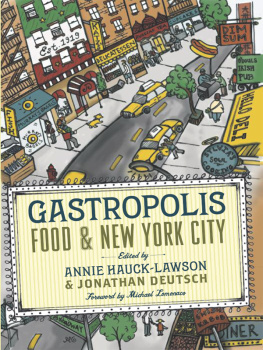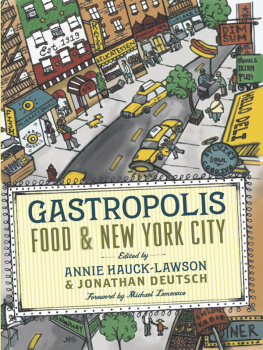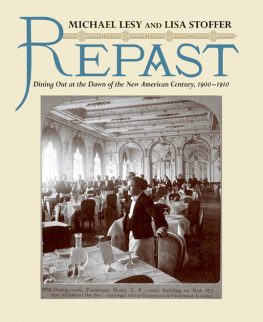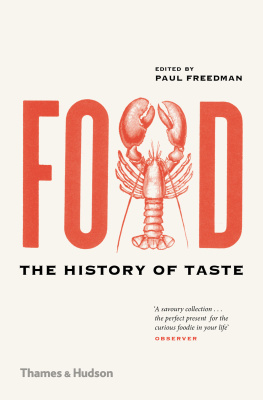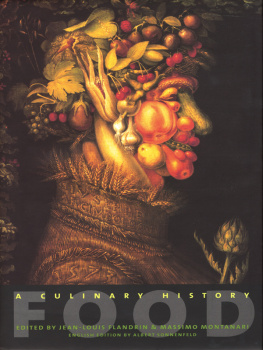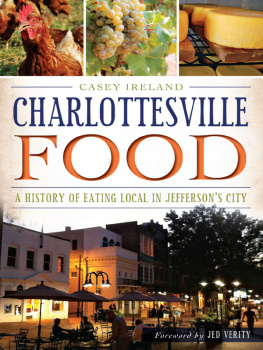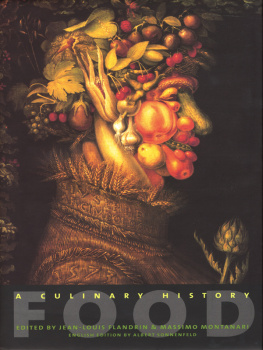GASTROPOLIS
Arts and Traditions of the Table: Perspectives on Culinary History
ALBERT SONNENFELD, SERIES EDITOR
Salt: Grain of Life, Pierre Laszlo, translated by Mary Beth Mader
Culture of the Fork, Giovanni Rebora, translated by Albert Sonnenfeld
French Gastronomy: The History and Geography of a Passion, Jean-Robert Pitte, translated by Jody Gladding
Pasta: The Story of a Universal Food, Silvano Serventi and Franoise Sabban, translated by Antony Shugar
Slow Food: The Case for Taste, Carlo Petrini, translated by William McCuaig
Italian Cuisine: A Cultural History, Alberto Capatti and Massimo Montanari, translated by ine O'Healy
British Food: An Extraordinary Thousand Years of History, Colin Spencer
A Revolution in Eating: How the Quest for Food Shaped America, James E. McWilliams
Sacred Cow, Mad Cow: A History of Food Fears, Madeleine Ferrires, translated by Jody Gladding
Molecular Gastronomy: Exploring the Science of Flavor, Herv This, translated by M. B. DeBevoise
Food Is Culture, Massimo Montanari, translated by Albert Sonnenfeld
Kitchen Mysteries: Revealing the Science of Cooking, Herv This, translated by Jody Gladding
Hog and Hominy: Soul Food from Africa to America, Frederick Douglass Opie
Columbia University Press
Publishers Since 1893
New York Chichester, West Sussex
cup.columbia.edu
Copyright 2009 Columbia University Press
Paperback edition, 2010
All rights reserved
E-ISBN 978-0-231-51006-6
Library of Congress Cataloging-in-Publication Data
Gastropolis : food and New York City / edited by Annie Hauck-Lawson and Jonathan Deutsch.
p. cm. (Arts and traditions of the table: perspectives on culinary history)
Includes bibliographical references and index.
ISBN 978-0-231-13653-2 (cloth : alk. paper)
ISBN 978-0-231-13652-5 (pbk. : alk. paper)
ISBN 978-0-231-51006-6 (e-book)
1. Food habitsNew York (State)New YorkHistory.
2. Food in popular cultureNew York (State)New York.
3. FoodSocial aspectsNew York (State)New York.
4. CookeryNew York (State)New York. I. Hauck-Lawson, Annie. II. Deutsch, Jonathan, 1977 III. Title. IV. Series.
GT2853.U5G37 2008
394.1'209747dc22
2008023536
A Columbia University Press E-book.
CUP would be pleased to hear about your reading experience with this e-book at .
References to Internet Web sites (URLs) were accurate at the time of writing. Neither the editors nor Columbia University Press is responsible for URLs that may have expired or changed since the manuscript was prepared.
With gratitude to my dear family and friends: my pit crew. You nourish my food voice. You rock! (AH-L)
To my family. (JD)
CONTENTS
Food Voice Narrative
Food Voice Narrative
Food Voice Narrative
Food Voice Narrative
EACH SEPTEMBER, when I was growing up in Brooklyn, we put up tomatoes that my father had grown in our backyard. Putting them up meant filling sterile glass jars with this valuable crop of home-grown Romas, which served to tide us over through the winter so that the Sunday gravy (Brooklyn Italian American for a particular pasta sauce, only we didn't call it pasta, but maccheroni) would have the rich taste of the sun, unlike the flaccid tomatoes that came packed in cans.
We had two peach trees in the same, small yard. Their fruit was best enjoyed after being bathed in red wine or put up in their own jars with some sugar, later to enjoy as a midwinter treat when nary a stone fruit was in sight, long before globalization brought us long-distance, gas-treated fruits from thousands of miles away. There was nothing as sweet and delicious as those peaches. Except, of course, the ripe, black figs from the two ample fig trees or the raspberries and blackberries from the bushes that grew beside the rear fence, just next to our neighbor's berry bushes, whose fruit she turned into Austrian compotes, like those her mother had made before they fled the combat of World War II. She also taught my mother, a Sicilian mama to the core, how to make dill pickles as only she, a Jewish mother, could do.
Green beans, tomatoes, basil, parsley, cucumbers, eggplants, and sweet bell peppers filled our yard every summer, all grown from seeds that had germinated in our cellar in the waning days of winter before the warm days of spring arrived. Those seedlings lived not far from homemade sausages made in late fall that were curing into dry salumi, hanging very near barrels of homemade wine, made from California grapes shipped to New York each autumn for Italian immigrant winemakers like my grandfather Salvatore.
My childhood sounds as though pulled from an ancient history book, not lived in Brooklyn in the late 1950s and early 1960s. My mother, Mary, was born to Sicilian immigrant parents on the Lower East Side and spoke the Sicilian dialect until she was five, when she learned English. My father, Frank, immigrated to the United States, leaving Sicily behind at the age of fifteen. We were urban-agrarian before it was part of the green movement. My mother cooked every day, using many ingredients from our backyard in season and from our cold-cellar stores of home-cured and preserved foods. Of course, the chickens, rabbits, and even Thanksgiving turkey were all free range from the live-poultry market, harvested to order. Meat from the butcher shop was cut from the sides of midwestern beef hung to dry; sausages were made from pork that likely came from heritage breeds before they were in vogue; fresh Jersey eggs were candled right in front of us; and espresso was brewed from beans from the coffee roaster whose only business was roasting coffee daily.
In Gastropolis: Food and New York City, Annie Hauck-Lawson and Jonathan Deutsch lead me to realize that I was not alone in this unique way of seeing and eating and that these experiences define me through my food voice, which has been unstoppable. It took shape during my childhood in my Brooklyn neighborhood, where the fusion of great Jewish delicatessens and dairy stores, next to the Italian salumeria and latticini, down the block from the Mittel-European sweet shop that made ice cream and the market that sold fish brought fresh from the dock, and on whose side streets plied 1940s-era trucks from which was sold produce grown in the Hudson Valley conspired to make food the central focus of my life.
Today, whether in my home kitchen or in my restaurant, my cooking is rooted in a Brooklyn-New Yorklaced story that draws on the diversity I have been exposed to, having eaten my way through this city, my hometown, transforming me as curing and aging do salumi; great ingredients, all ground and mixed together, with time and patience, yield something different and entirely original. And so in my own food voice, with my New Yorkcured taste, I feel as though I have become a part of the city and, with luck, contribute to and mentor the formation of someone else's food voice.
Taking my food voice to the streets, as a chef and restaurateur, came later in life. While I didn't know that was where I was headed, I wasn't surprised when I arrived. In my late twenties, tiring of life as a struggling actor, I found my true voice in cooking, by way of Brooklyn, earning my degree in hospitality at the New York City College of Technology in the 1980s. Since boyhood, I have sought out the New York food experience, traveling the boroughs in search of a perfect, usually ethnic meal. As the city's world population has grown, so have my tastes for the authentic from around the globe. I have long believed that New Yorkers can taste their way through most of the cuisines of the world without leaving the five boroughs. This global connection has influenced the food I cook at home as well as in the restaurant. I credit the food of New York for having informed and helped me find my own personal voice, the food voice that I rely on each day for my livelihood. And I know that I am not alone in this experience; I know many chefs who seek out ethnic-food markets to find the authentic ingredients they need to create their own style of cooking. New York is like an incubator for great cooking, recognized around the world for being a center of innovationwith great chefs, ethnic markets, and farmers marketsand a catalyst for creativity. You can find your true food voice in New York; you just need a guidebook like
Next page
